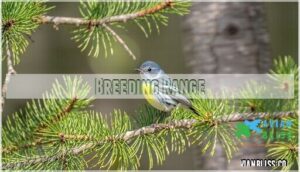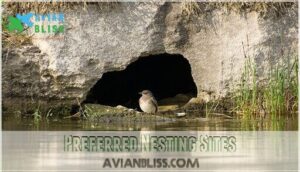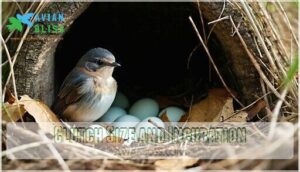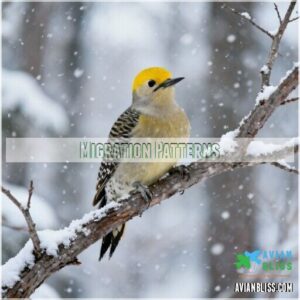This site is supported by our readers. We may earn a commission, at no cost to you, if you purchase through links.

Unlike their social Bank Swallow cousins, these birds prefer flying solo or in small groups along rivers and streams.
They’re North America’s plainest swallow, lacking the distinctive markings that make other species stand out.
You’ll spot them flying low over water during summer months throughout the United States and southern Canada.
These solitary nesters choose burrows made by other animals or squeeze into human-made spaces like drainpipes and bridge crevices.
Their unassuming appearance often makes them the overlooked member of the swallow family, and they are usually found flying solo, which is a key characteristic of the northern rough winged swallow.
Table Of Contents
- Key Takeaways
- Northern Rough Winged Swallow
- Habitat and Distribution
- Behavioral Habits
- Reproduction and Nesting
- Migration Patterns
- Frequently Asked Questions (FAQs)
- What is a northern rough-winged swallow?
- Where is northern rough-winged swallow found?
- Is there a rough winged swallow in North America?
- What does a rough winged swallow look like?
- What is the status of the northern rough-winged swallow in Tennessee?
- Where do northern rough-winged swallows live?
- What is an interesting fact about the northern rough-winged swallow?
- What is the difference between a chimney swift and a rough-winged swallow?
- What is the difference between northern and southern rough-winged swallow?
- Do Rough-winged Swallows migrate?
- Conclusion
Key Takeaways
- You’ll spot them flying solo – Unlike social Bank Swallows, northern rough-winged swallows prefer solitary or small group flights over water, making them easy to distinguish from their flocking cousins.
- They’re North America’s plainest swallow – You’ll recognize them by their understated brown backs, grayish throats, and square tails, lacking the flashy markings that make other swallow species stand out.
- You’ll find them near water sources – These sparrow-sized birds hunt flying insects over rivers, streams, and lakes throughout the United States and southern Canada during breeding season.
- They’re adaptable nesters – You’ll discover them using burrows made by other animals or squeezing into human-made spaces like drainpipes, bridge crevices, and culverts rather than building traditional nests.
Northern Rough Winged Swallow
You’ll recognize the Northern Rough-winged Swallow by its plain brown back and white belly with a dusky throat that looks like it forgot to wash its face.
This unassuming brown bird flies like it owns the sky, snatching insects with casual precision.
This sparrow-sized aerial acrobat measures about 5 inches long with serrated wing edges you can only see up close—nature’s tiny saw blade disguised as a bird, with serrated wing edges being a notable feature.
Physical Description
You’ll spot the Northern rough winged swallow’s distinctive silhouette soaring overhead with its long, pointed wings and distinctly square tail.
This sparrow-sized aerial acrobat measures 4.7-5.9 inches with a wingspan stretching 10.6-11.8 inches.
Key Physical Features:
- Color patterns: Plain brown upperparts with white belly and buffy throat
- Wing shape: Broad, pointed wings with serrated outer feathers (visible only up close)
- Tail features: Square or slightly notched tail with white undertail coverts
- Beak size: Small, compact bill perfect for catching insects mid-flight
- Feather texture: Smooth brown plumage above, clean white below with subtle throat wash
The Northern rough winged swallow’s flight capabilities are influenced by its hollow bone structure, which reduces weight and enhances aerodynamics.
Identification Features
You’ll recognize this swallow by its plain brown upperparts and distinctive square tail that sets it apart from other species.
The Northern Roughwinged Swallow’s plumage patterns show uniform brown coloring above with white underparts and a subtle brownish wash across the throat.
Its beak shape is small and typical of aerial insectivores.
The tail features are particularly helpful for bird identification – look for that squared-off end rather than the forked tails of other swallows.
Most remarkably, the wing edges contain tiny serrations on outer feathers, giving this species its name, though you’ll need binoculars to spot this feather texture detail during swallow characteristics observation.
Size and Weight
You’ll find the Northern Rough-winged Swallow falls between a Ruby-throated Hummingbird and Purple Martin in relative size.
These sparrow-sized birds measure 4.7-5.9 inches long with a 10.6-11.8 inch wingspan.
Body Mass ranges from 0.3-0.6 ounces, making them lightweight aerial hunters.
Wing Length and compact build help them maneuver efficiently.
Their measurements show consistent bird size comparison standards across both sexes, with "Ridgway’s" subspecies appearing remarkably larger and lankier than typical populations.
Habitat and Distribution
You’ll discover this adaptable swallow across a vast range from southern Canada to central Mexico, with populations spreading throughout most of the continental United States.
Unlike many swallow species, Northern Rough-winged Swallows don’t demand specific habitat types but do show a strong preference for areas near water sources like rivers, streams, and lakes where insects are abundant.
Breeding Range
You’ll discover this swallow’s breeding range spans most of North America, from southern Canada to central Mexico.
The northern rough winged swallow’s geographic range covers every U.S. state except Hawaii and Alaska during bird breeding season.
Their habitat preferences include open areas near water sources, with nesting sites in riverbanks, quarries, and human-made structures, which showcase remarkable adaptability across diverse landscapes.
Understanding the bird breeding range is vital for conservation efforts, which involve managing ideal breeding range habitats, and this knowledge is key to effective conservation.
Wintering Grounds
When winter arrives, these agile aerial hunters escape to warmer territories spanning Mexico through Central America and southern Florida.
You’ll discover wintering grounds concentrated in lowland areas where rivers and agricultural fields provide abundant flying insects.
Migration routes lead south from breeding grounds, with most birds departing by mid-September.
Winter habitats feature open terrain near water sources, supporting large communal flocks in sugar cane fields and marshes.
Bird migration patterns reveal consistent roosting sites where northern rough winged swallow populations gather for survival and protection.
The northern rough winged swallows’ feeding behavior habits play a vital role in their ability to thrive in these wintering grounds with abundant flying insects.
Preferred Nesting Sites
You’ll spot these cavity-nesting birds establishing homes in diverse vertical surfaces.
Northern Rough-winged Swallows practice solitary nesting, choosing burrow selection sites in riverbank locations, road cuts, and quarries.
Unlike colonial species, they prefer nest crevices in bridge structures, cliff dwellings, and abandoned tunnels.
Their nesting habits include constructing burrows one to six feet deep, using grass and twigs for nest construction materials.
Behavioral Habits
You’ll notice these aerial acrobats have some fascinating behavioral quirks that set them apart from their swallow cousins.
Unlike other swallows that love to party in large flocks, Northern Rough-winged Swallows prefer the solo life, typically foraging alone over rivers and fields with their characteristic low, swift flight patterns.
Feeding Behavior
Watch these aerial forager masters snatch flying insects with remarkable precision.
Northern Rough-winged Swallows demonstrate exceptional feeding behavior, capturing flies, beetles, and moths mid-flight.
Their insectivorous diet focuses on water foraging over rivers and ponds where prey concentrates.
These aerial foraging specialists adjust their feeding strategies based on insect abundance, targeting peak activity periods when their quarry emerges.
Foraging Techniques
You’ll witness these aerial foraging masters employing sophisticated insect capture techniques during flight.
Their flight patterns involve swift, low-altitude sweeps over water and open ground, typically hunting 2-10 meters above surface level.
These insectivorous birds excel at mid air hunting, snatching flies, beetles, wasps, and moths with precision timing.
Their feeding strategies adapt to peak insect activity during morning and late afternoon hours when flying insects are most abundant, utilizing sophisticated techniques to maximize their catch.
Social Behavior
Unlike other swallows that gather in massive flocks, you’ll notice Northern Rough-winged Swallows prefer a more independent lifestyle.
These birds don’t form colonies like Bank Swallows, instead nesting as solitary pairs or small groups.
Their social structure remains loose even during migration.
You’ll observe minimal territorial behavior during breeding season, with males displaying white tail feathers during courtship.
Their mating rituals are understated compared to flashier species, focusing on practical nest-site selection over elaborate displays.
Their approach to mating is a key aspect of their behavior, highlighting a preference for practical choices.
Reproduction and Nesting
You’ll find Northern Rough-winged Swallows aren’t big on the whole "community living" thing in regards to raising their young.
Unlike their Bank Swallow cousins who pack together in noisy colonies, these birds prefer the solo parenting approach with just occasional neighborly tolerance, which reflects their preference for solo parenting.
Clutch Size and Incubation
Understanding northern roughwinged swallow reproduction starts with timing.
You’ll find these birds laying 4-8 eggs per clutch, typically 5-7, with larger broods in northern regions.
The female handles incubation alone for 16-17 days while males stand guard nearby.
Researchers study the species’ rough feather structure to better understand its adaptive significance.
Key Clutch Size and Incubation Facts:
- Egg Laying occurs May through June, timed with peak insect abundance
- Incubation Period lasts exactly 16-17 days with female-only duties
- Nesting Success depends heavily on site protection from flooding and predators
- Fledging Rate improves when parents coordinate feeding schedules effectively
- Brood Size averages 6 eggs, with northern populations producing larger clutches
Nestlings emerge helpless and naked, requiring intensive parental care until they’re ready to leave their burrow nesting sites.
Nesting Sites and Materials
You’ll find these swallows setting up shop in various cavity choices, from natural burrows to man-made structures.
Their burrow selection process involves scouting vertical banks, bridge crevices, and abandoned tunnels. Site reuse is common when locations prove successful.
The use of bird nesting boxes can also provide alternative nesting sites for these swallows.
| Natural Sites | Human-Made Sites | Nest Architecture |
|---|---|---|
| Rock crevices | Drain holes | Grass lining |
| Riverbank burrows | Road cuts | Weed stems |
| Tree cavities | Bridge structures | Twig foundation |
Material gathering focuses on practical items. These swallows collect grass, small twigs, and plant stems to construct their nests 1.5 to 7 feet inside chosen cavities, creating cozy chambers for their nestlings.
Parental Care and Fledging
Once your northern roughwinged swallow chicks hatch, both parents share nestling care duties equally.
They’ll make countless trips delivering flying insects to fuel rapid chick development during the eighteen to twenty-one day fledgling stage.
This intensive parental feeding continues even after young birds leave the burrow, ensuring proper brood rearing success through those critical first flight attempts, which is crucial for the chicks’ overall development and rapid chick development.
Migration Patterns
You’ll notice Northern Rough-winged Swallows follow predictable seasonal patterns as they escape harsh northern winters.
These aerial acrobats travel from their breeding grounds across southern Canada and the United States to warmer territories in Mexico, Central America, and southern Florida, exhibiting a notable example of seasonal migration.
Seasonal Movements
Timing matters when you’re tracking these aerial acrobats. Northern rough-winged swallows begin their southward journey in late August, peaking during September.
You’ll notice decreased sightings as flocking patterns shift from solitary foraging to loose groups. These migratory birds demonstrate remarkable altitude changes, dropping from higher elevations to follow river valleys.
Stopover sites become essential refueling stations during swallow migration, where northern swallows gather briefly before continuing south through seasonal bird sightings documented along consistent bird migration patterns. Understanding the bird migration guide principles is essential for effective tracking and conservation efforts, which involve following the bird migration patterns to ensure the well-being of the northern swallows.
Migration Routes
You’ll follow two main flyway patterns during spring migration – the eastern and Pacific routes.
Eastern populations typically arrive at breeding grounds slightly earlier than their western counterparts. These swallow migration routes take you through the Gulf Coast as you travel from wintering areas in Mexico and Central America.
Some northern swallows choose stopover sites along major river systems for refueling. Bird migration patterns show these routes often overlap with other species, creating mixed flocks during transit periods.
Understanding bird migration routes is essential for conservation efforts and protecting these species.
Wintering Habits
Once these swallows reach their wintering grounds in southern Florida, Mexico, and Central America, they adapt their lifestyle completely.
You’ll discover them roosting in different spots and adjusting their daily routines.
During winter months, northern rough winged swallows modify their behavior patterns:
- Winter Roosts – They gather in protected areas like dense vegetation or man-made structures
- Flocking Behavior – Unlike breeding season, they’ll join mixed-species groups for safety
- Food Sources – They hunt insects over tropical wetlands and agricultural areas
- Habitat Selection – They prefer lowland regions with abundant water sources.
Migration timing varies, but most birds return north by March.
Frequently Asked Questions (FAQs)
What is a northern rough-winged swallow?
You’ll recognize this sparrow-sized aerial acrobat by its brown upperparts and white belly.
It’s a solitary swallow that catches flying insects over water, nesting in burrows along riverbanks across North America.
Where is northern rough-winged swallow found?
You’ll find these birds throughout North America, from southern Canada down to central Mexico. They breed near water sources like rivers, lakes, and streams, preferring sandy banks for nesting burrows.
Is there a rough winged swallow in North America?
Yes, you’ll find the Northern Rough-winged Swallow throughout North America. It breeds from southern Canada down to central Mexico, making it a common sight across the continent during warmer months.
What does a rough winged swallow look like?
Like spotting a sparrow in hiking boots, you’ll notice this plain brown bird’s distinctive square tail and white belly.
It’s sparrow-sized with broad wings, flying low over water with swift, direct flight patterns, showcasing its distinctive features.
What is the status of the northern rough-winged swallow in Tennessee?
You’ll find this swallow’s status in Tennessee remains stable.
It nests in small colonies or isolated pairs depending on nest site availability and is classified as least concern by the IUCN.
Though populations show gradual decline.
Where do northern rough-winged swallows live?
You’ll spot these swallows across North America from southern Canada to central Mexico.
They prefer areas near water like rivers, streams, and lakes, nesting in burrows along sandy banks or man-made crevices under bridges.
What is an interesting fact about the northern rough-winged swallow?
You’d never guess this tiny aerial acrobat‘s name comes from microscopic serrations on its wing feathers—invisible to the naked eye but perfectly designed for cutting through air with remarkable precision.
What is the difference between a chimney swift and a rough-winged swallow?
You’ll spot chimney swifts by their cigar-shaped bodies and boomerang wings flying high, while rough-winged swallows have broader wings and fly lower near water with their distinctive square tails.
What is the difference between northern and southern rough-winged swallow?
Different subspecies create confusion when you’re trying to tell these birds apart.
Northern Rough-winged Swallows are smaller and more compact, while Southern Rough-winged Swallows are slightly larger with longer wings and a more deeply forked tail, helping you distinguish them in overlapping ranges.
Do Rough-winged Swallows migrate?
Yes, you’ll find Rough-winged Swallows are migratory birds.
They breed across North America from southern Canada to central Mexico, then winter in southernmost Florida, Mexico, and Central America.
Before returning north.
Conclusion
Statistics show that northern rough winged swallows can live up to nine years in the wild.
Now you’ll recognize this understated bird by its brown back and grayish throat patches that distinguish it from flashier relatives.
You’ve learned about their solitary nesting habits and preference for human-made structures like bridges and culverts.
The northern rough winged swallow may lack bold markings, but its adaptability and widespread distribution make it a fascinating species worth watching along waterways throughout North America.
- https://macaulaylibrary.org/photo/57691061
- https://www.laspilitas.com/California_birds/Swallows/Northern_Rough_winged_swallow/northern_rough-winged_swallow.html
- https://www.allaboutbirds.org/guide/Northern_Rough-winged_Swallow/lifehistory
- https://nrm.dfg.ca.gov/FileHandler.ashx?DocumentID=1979
- https://www.audubon.org/field-guide/bird/northern-rough-winged-swallow










